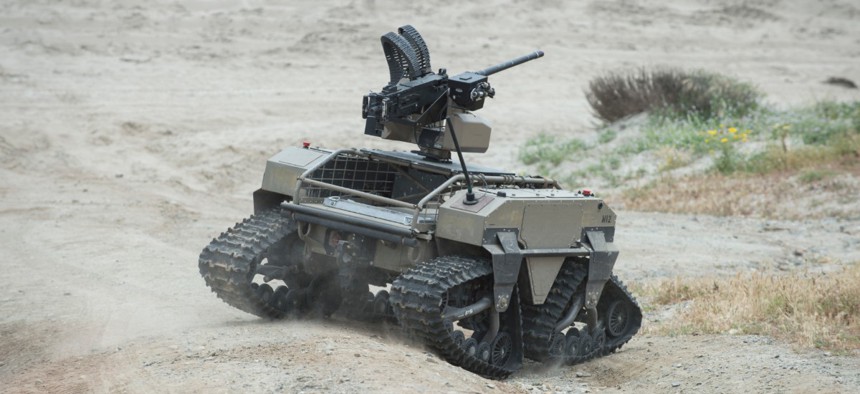The Future of the Marines Is Smaller, More Robotic, More Naval

A unmanned vehicle, part of the Multi-Utility Tactical Transport family of systems, operates on Red Beach during the Ship-to-Shore Maneuver Exploration and Experimentation Advanced Naval Technology Exercise 2017. John F. Williams/Navy
The new Commandant of the Marine Corps lays out a vision for high-tech force that will often operate like special forces.
The Marine Corps of the future is more likely to be smaller than bigger. It will rely more on sea, air, and land drones to aid the leathernecks storming the beach, and do more to defend warships. It will work in smaller, distributed teams with low signatures, closer to the way Special Operations Forces have worked traditionally, according to Marine Corps Commandant Gen. David Hilberry Berger.
On Thursday, Berger was at the Heritage Foundation to discuss the Commandant’s Planning Guidance he released in July, just 10 days after stepping into the Corps’ top job. Among the biggest changes Berger wants: work more closely with the Navy to defend ships.
“We have not focused on that aspect in nearly twenty years,” he said. “That could mean Marines ashore or afloat with longer-range anti-ship missiles… Envision them as an extension of the fleet’s magazine, augmenting air- and ship-based fires.”
It will also mean taking weapons that the Marines use on land and “strapping” them onto the decks of ships.This is already happening; in July, Marines aboard the USS Boxer used an experimental jammer called the Light Marine Air Defense Integrated System, or LMADIS, to down an Iranian drone within 1,000 feet of the ship. “We’ll need to do a lot more of that,” Berger said.
The Marines have also begun deepening their experiments with drones, Berger said, as at as the 2017 Ship-to-Shore Maneuver Exploration and Experimentation Advanced Naval Technological exercise at California’s Red Beach.
Related: Marines: ‘The First One Through the Door Should Be a Lethal Robot’
But there’s a big difference between exercising new concepts and actually working new drones into the force in a big way. “The initial driver [for integrating robots into operations] was: don’t put a human being in there when you can put a machine in there, and lower the risk to the human. Now the additive part of unmanned is how can you make your force look bigger, operate bigger with unmanned / manned teaming? How can my wingman, or two of them, be unmanned? How does that enable me to accomplish the mission in a better way?”
Berger said that will take big changes from the top on down. “Unless you artificially demand a rate of advancement, it won’t happen. It’s not that we don’t like them, it's just that everything is built to be manned...So unless you say, ‘Five years from now, I want 50 percent of it unmanned.’ Okay, now you’re driving it. You may not achieve that but you need a driver.”
The operators teaming with those machines will also fight differently. The Marines, Berger said, are exploring new “methods like expeditionary advanced bases, small units, distributed, mobile, that can re-arm, refuel, sense forward, kill forward, and then move, all with a low signature.”
They’ll also be working with a wider variety of ships, including greater collaboration with commercial cargo vessels and fleets. “The civilian mariner aspect of it is absolutely in play. We should not push it off the table just because it’s manned by civilian mariners,” he said. “What I know will not work is a few dozen old grey L-Class ships by themselves,” he said. . “They will be targets. We need them but we need much more than just that. We have to be much more creative in how we use… E-class ships,” he said. “For a while, we were standoffish from [them] because we thought they threatened the amphibious ship-building plan. ‘Don’t talk about them because then we get enough amphib ships.’ We’re in a place now where we need all of that. We need to really think creatively now how we embark forces and systems on platforms that are not necessarily an LPD-17 or... an LHA/LHD [amphibious assault ship]. If they’re floating, we need to figure out how to use them.”
But there are bigger reforms taking place as well. The Marines, as well as other military services, are reviewing conventional rules for engagement, he said, and questioning if they’re suited for situations where conflict happens below the threshold of war and where the distinction between adversary and non-adversary is blurred.
“Our rules of engagement, our standing joint rules of engagement, are not built for what some people would call grey-zone competition…The world we live in right now,” he said. “Our standing rules of engagement, they’re challenged there. Yes, we are sorting our way through that.”
NEXT STORY: Air Force CXO: We Don’t Have to Delight the User






